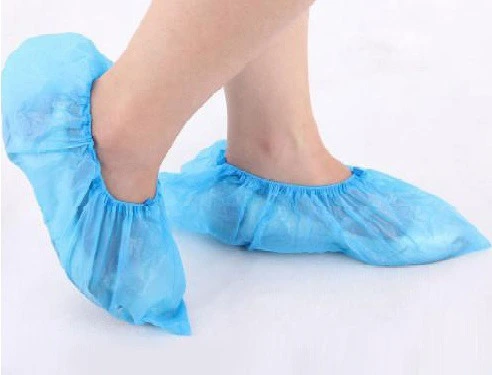
Top 5 Benefits of Using Non-Woven Disposable Shoe Covers Daily
- 1. What Are Medical Scrubs, and Why Are They Essential in Healthcare?
- 2. Choosing the Right Scrub Top for Your Body and Needs
- 3. The Power of Multi-Pocket Design in Medical Scrubs
- 4. Comfort, Fabric, and Durability That Lasts All Day
- 5. Why StitchMD Is the Best Choice for Men’s Scrub Tops with Pockets
- 6. Why do men’s scrub tops need pockets?
- 7. Are men’s scrub tops with pockets available in different sizes?
- 8. Do these scrub tops shrink after washing?
- 9. Can I buy matching pants for my scrub top?
- 10.Are the pockets deep enough for phones and scissors?
Keeping things clean and preventing contamination is crucial in healthcare settings, cleanrooms, food production, and even in our own homes. One handy tool that helps us achieve this is the use of non-woven disposable shoe covers. These lightweight and budget-friendly covers serve as a protective barrier, stopping dirt, dust, and bacteria from moving between different areas.
Whether you’re managing a hospital, working in a lab, or just trying to keep your home tidy, using shoe covers daily can really make a difference. In this article, we’ll dive into the top 5 benefits of incorporating non-woven disposable shoe covers into your routine—and why they deserve a spot in every safety kit.

What Are Non-Woven Disposable Shoe Covers?
Non-woven disposable shoe covers are protective foot coverings crafted from synthetic fibers that are bonded together without the need for weaving or knitting. Unlike reusable options made from cloth or rubber, these are meant for one-time use and should be tossed after each wear. Their non-woven design provides breathability, flexibility, and lightweight protection, making them perfect for sterile or sensitive environments.
You’ll often find these shoe covers in hospitals, pharmaceutical labs, cleanrooms, food processing plants, and even during home visits or repairs.
1. Hygiene and Contamination Control
The biggest advantage of using non-woven disposable shoe covers is their role in preventing contamination. In sterile settings like operating rooms, cleanrooms, or labs, it’s essential to keep dust, bacteria, and pathogens from being brought in from the outside.
Shoes can carry germs, debris, and chemicals picked up from public spaces, and without proper protection, these can easily transfer onto clean floors, equipment, or even patients.
StitchMD Bulk Packs – Disposable Shoe Covers
By wearing shoe covers, both staff and visitors become the first line of defence against potential infection risks.
2. Cost-Effective and Disposable
Non-woven shoe covers are crafted for single use and mass production, making them super budget-friendly. They cut out the hassle of washing, sanitizing, or maintaining reusable covers, which means you save both time and labor costs.
These covers come in bulk and are lightweight, so they’re easy to store and distribute without taking up too much room.
For clinics, food factories, or even real estate firms showing properties, disposable covers offer hygiene assurance without breaking the bank.
3. Easy to Use and Comfortable
One of the standout benefits of non-woven disposable shoe covers is how user-friendly they are. Most feature an elastic opening that lets you slip them on over your shoes in a flash—no tying, taping, or fussing around needed.
Key features include:
- Universal sizing
- Lightweight, breathable fabric
- Non-slip sole options (perfect for wet or sterile floors)
At StitchMD, we provide non-woven shoe covers with sturdy elastic bands to ensure a snug fit for all types of shoes, from dress shoes to sneakers and boots.
4. Versatile for Many Environments
While they’re often associated with medical settings, non-woven disposable shoe covers are now making their mark across various industries and even in homes.
Common use cases include:
- Hospitals and clinics
- Pharmaceutical and biotech labs
- Cleanrooms and manufacturing units
- Food and beverage processing
- Pest control and sanitation work
- Home cleaning and repair visits
- Real estate property showings
WHO Environmental Hygiene Guidelines
This versatility makes shoe covers an essential item for any professional or facility that values hygiene.
5. Supports Infection Control Protocols
Many health and safety guidelines suggest or even require the use of non-woven disposable shoe covers to help prevent the spread of contaminants. When included in a complete PPE (Personal Protective Equipment) setup, they play a vital role in infection control and help meet hygiene standards.
Non-Woven Disposable Bouffant Cap
Wearing shoe covers demonstrates to your staff, clients, and patients that you prioritise safety and professionalism.
How to Use Non-Woven Disposable Shoe Covers Properly
Application Tips
- Always put them on in a clean area.
- Make sure your shoes are fully covered.
- If needed, use both hands to ensure a snug fit.
Disposal Best Practices
- Use them once and toss them right away.
- Dispose of them in a designated bin for contaminated PPE.
- Avoid washing or reusing them.
Who Should Use Shoe Covers Daily?
If you’re in any of the following professions, wearing shoe covers every day is highly advisable:
- Doctors and nurses
- Lab technicians
- Cleanroom or pharmaceutical staff
- Food safety inspectors
- Home care providers
- Maintenance and service personnel
- Real estate professionals
Using non-woven disposable shoe covers daily helps keep your environment—and your reputation—clean and professional.
Conclusion
Though they may be small, non-woven disposable shoe covers are crucial for promoting hygiene, minimising contamination risks, and enhancing safety across various settings. With their affordability, comfort, and ease of use, they’re a must-have in any workplace or facility where cleanliness is key.
Looking for dependable, high-quality non-woven disposable shoe covers? Order now from StitchMD and ensure your environment stays protected—every step of the way.
1. What is used to make non-woven disposable shoe covers?
2. Is it possible to reuse non-woven shoe covers?
3. In what contexts are non-woven disposable shoe covers frequently utilised?
